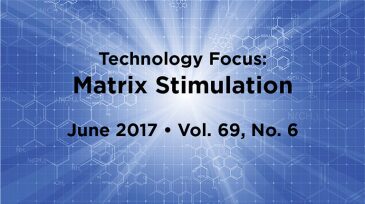stimulation
-
The evolution of horizontal drilling and multistage completions has changed matrix stimulation from the “more acid, better result” belief to effective lateral distribution and deeper penetration with less acid.
-
The case history presented in the complete paper describes the performance of an acid-fracturing intervention in an HP/HT well in which this intervention was the last procedure considered to evaluate the productivity of a Marrat Formation well.
-
The authors discuss a new way of extracting deformation information from radar imagery, contributing to improved accuracy of InSAR surface-elevation monitoring.
-
The treatment in a deepwater, frac-packed well with fiber-optic-equipped coiled tubing (CT) and a rotating, hydraulic high-pressure jetting tool achieved successful stimulation of a 500-ft-long frac-packed zone after several previous failures using different techniques.
-
This paper discusses a novel approach to abrasive perforating, including the first-ever use of an acid-soluble abrasive material and ending with CT-jetting-assisted nitrified stimulation.
-
Tight formations are candidates for hydraulic fracturing as the default. However, the solubility of carbonate by various chemicals provides opportunities to extend the well drainage radius effectively without the intensive equipment, material, and infrastructure demand of hydraulic fracturing.
-
This paper studied three residual-free fluid systems for acid treatments and fracturing in order to develop no-damage or reduced-damage and highly effective stimulation techniques for long-interval wells.
-
While there is increased scrutiny from regulatory and community stakeholders on the chemicals used in operations, complex and technically challenging reservoirs must be developed to replace reserves. Matrix stimulation remains a critical technology for delivering barrels at minimum cost.
-
Hydraulic fracturing exerts transient geomechanical forces near the wellbore, enabling a brief time interval in which a second hydraulic fracture can be created in a different direction.
-
A tight gas carbonate reservoir with no oil rim in a supergiant onshore gas field in Abu Dhabi was targeted for stimulation during a field review to increase field production.







